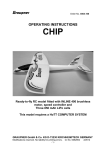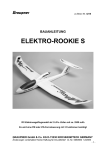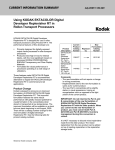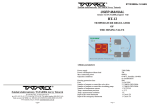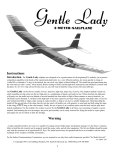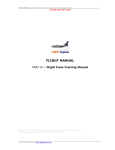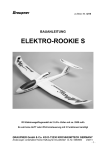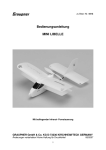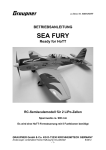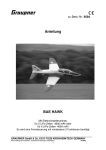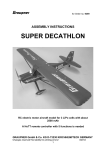Download OPERATING INSTRUCTIONS
Transcript
Order No. 4564.HOTT OPERATING INSTRUCTIONS CHIP Ready-to-fly RC model fitted with INLINE 400 brushless motor, speed controller, Three 850 mAh LiPo cells and HoTT receiving system This model requires a HoTT COMPUTER SYSTEM GRAUPNER GmbH & Co. KG D-73230 KIRCHHEIM/TECK GERMANY Modifications reserved. No liability for printing errors. -1- Id. No. 0062266 9/2011 Please be sure to read through the safety notes in the Appendix to these operating instructions. If you ever dispose of the model, it is important to pass on the complete operating instructions to the new owner. Introduction The CHIP is an ideal first hot-liner. The model is very highly pre-fabricated, but it is still important to complete the procedures described in these instructions with the greatest care to ensure that the model flies well and safely. Please start by reading right through these operating instructions - before you attempt to operate the model and make yourself familiar with the method of operating your HoTT transmitter. Keep the manual for your HoTT COMPUTER SYSTEM to hand when preparing the model. Pack contents 1. Fuselage with factory-installed INLINE 400 brushless motor including assembled CAM FOLDING PROP. Pre-fitted DES 231 rudder and elevator servos, Graupner GR-12S HoTT receiver, speed controller, carbon-look canopy with Velcro closure. 2. Wing with CFRP spar, decals applied 3. Tailplane with elevator horn 4. 3/850 LiPo battery, 11.1 V / 0.85 Ah, Order No.7621.3BEC, with safety notes 5. 4564.HOTT operating instructions in German, English and French 6. Box and operating instructions for GR-12S, operating instructions for BRUSHLESS CONTROL 18 speed controller, various promotional brochures Essential accessories (not included) GRAUPNER HoTT COMPUTER SYSTEM transmitter Transmitter battery charge lead Charge lead with BEC connector ULTRA TRIO PLUS 14 battery charger min. MX 12 to MC 32 Order No. 3022 Order No. 3037 Order No. 6466 Tool required to assemble the model (not included) Cross-point screwdriver Assembling the model The model can very quickly be prepared for the air, but it is important to read and observe the following notes, as this will avoid problems, especially on the first flight. Locate the horn, which is already glued in the elevator, connect it to the elevator pushrod at the tail end of the fuselage, then fix the tailplane to the fuselage using the M4 x 15 countersunk screw supplied; a suitable cross-point screwdriver is required. The model is completed by fixing the wing to the fuselage using two M4 x 30 mm screws. Fix the LiPo flight battery in the fuselage using the Velcro tape supplied. Binding the GR-12S receiver in the model to your HoTT transmitter The “BINDING” procedure varies according to the HoTT COMPUTER SYSTEM you are using; please observe the following notes, and the section entitled “Binding the receiver” in the manual supplied with your radio control system. 1. Give the LiPo flight battery and the transmitter battery a full charge. 2. Locate the right-hand stick on your transmitter, and move it back towards you to the “motor stop” position. 3. Now connect the BEC plug and socket between the speed controller and the LiPo battery. GRAUPNER GmbH & Co. KG D-73230 KIRCHHEIM/TECK GERMANY Modifications reserved. No liability for printing errors. -2- Id. No. 0062266 9/2011 4. Initiate the “BINDING” procedure, and then carry out a full check of the working systems. The servo leads should be connected to the receiver in the following sequence: socket 1: speed controller; socket 2: rudder servo; socket 3: elevator servo. This means that the throttle (motor control) and direction (rudder control) are both assigned to the right-hand stick on the transmitter, and the elevator to the left-hand stick. Pulling the elevator stick back towards you causes the elevator to deflect up; moving it away from you causes it to deflect down. 5. If necessary, use your transmitter’s “Servo settings” menu to correct the direction of rotation of the servos, and set the control surfaces exactly to centre (neutral position). This is very important, otherwise the model will not fly straight, and will constantly tend to climb or dive. 6. Now it is time to check the motor function by cautiously moving the right-hand stick forward (away from you). It is always better to test the motor outdoors, and it is very useful to have a friend to hold the model securely while you operate the transmitter. This photo shows the completed BEC connection between the speed controller and the LiPo battery. The receiving system is switched on and off by connecting and disconnecting the BEC plug and socket. Control surface travels The following maximum travels are possible with the standard servo output arms and horns: rudder 40 mm either side of neutral, measured at the bottom edge. Elevator 25 mm up and down, measured at the centre of the control surface. For the first few flights we recommend that you reduce these travels to 50% of these values. Please refer to your HoTT COMPUTER SYSTEM manual for information on this process. Balancing The correct Centre of Gravity coincides with the CFRP wing spar, i.e. 63 mm aft of the wing root leading edge; you may need to adjust the position of the flight battery to achieve this. Fix the battery securely with Velcro tape. Support the model at the stated CG position with two fingers under the wing roots, and allow it to hang freely: the fuselage will remain level when the model is balanced correctly. GRAUPNER GmbH & Co. KG D-73230 KIRCHHEIM/TECK GERMANY Modifications reserved. No liability for printing errors. -3- Id. No. 0062266 9/2011 Test-flying For the first flight of any model aircraft it is helpful to enlist an experienced model pilot to assist you in checking and test-flying the model. Wait for a day with little or no breeze for the initial test-flight. The ideal flying site is a flat, unobstructed grassy field. Assemble the model completely. Switch the motor on and give the model a hand-launch exactly into any breeze; trotting forward for a few steps gains the necessary momentum. Use minimal rudder commands at first just to keep the model flying straight. Fine-tuning can be carried out by adjusting the trim buttons situated below and adjacent to the transmitter sticks. Initially it is best to keep all control commands small to avoid overcontrolling. As far as possible, fly the model in straight lines, and keep turns wide and shallow. Important: a brief application of the rudder causes the model to bank and start turning; return the rudder stick to neutral immediately afterwards. If you hold the rudder on too long, or use it too heavily, the model will fall into a spiral dive. Always land the aeroplane directly into wind, with the motor switched off. Just before touch-down, apply slight up-elevator to flare out and slow the machine down further. Always land directly into wind. When you have gathered some experience in flying the model, you can increase the control surface travels. With large travels the aeroplane is capable of high-speed flight manoeuvres due to its low inertia. However, it is still capable of circling away in thermals when the motor is switched off. All of us at GRAUPNER Modellbau wish you many fine flights with your CHIP Specification - CHIP Wingspan approx. Overall length approx. Wing section Tailplane section Wing area Tailplane area Total surface area All-up weight approx. Total area loading approx. 1050 mm 810 mm RG 14 mod. NACA 009 17.1 dm² 3.7 dm² 20.8 dm² 500 g 24 g/dm² GRAUPNER GmbH & Co. KG D-73230 KIRCHHEIM/TECK GERMANY Modifications reserved. No liability for printing errors. -4- Id. No. 0062266 9/2011 Environmental protection notes The presence of this symbol on a product, in the user instructions or the packaging, means that you must not dispose of that item in the ordinary domestic waste when the product comes to the end of its useful life. The correct method of disposal is to take it to your local collection point for recycling electrical and electronic equipment. Individual markings indicate which materials can be recycled and re-used. You can make an important contribution to the protection of our shared environment by re-using the product, recycling the basic materials or re-processing redundant equipment in other ways. Dry cells and rechargeable batteries must be removed from the device and taken separately to a suitable battery disposal centre. If you don’t know the location of your nearest disposal centre, please enquire at your local council office. Safety Notes Before you fly the model for the first time it is essential (and a legal requirement) to take out an insurance policy designed to cover modelling risks. Be sure to read right through the instructions covering assembly and operation of your model before you attempt to operate it for the first time. You alone are responsible for the safe operation of your radio-controlled model aeroplane. Young people should only be permitted to build and fly this model under the instruction and supervision of an adult who is aware of the hazards involved in flying an RC model aircraft. In legal terms our models are classed as aircraft, and as such are subject to statutory regulations and restrictions which must be observed. Our brochure “Modellflugrecht, Paragrafen und mehr” (Model Aviation Law, Legal Requirements and more) is available under Order No. 8034.02, and contains a summary of all these rules; your local model shop should have a copy which you can read. It is important to use only those parts included in the kit, together with other genuine Graupner accessories and replacement parts as recommended expressly by us. Even if you change a single component, you can no longer be sure that the whole system will work reliably, and such changes also invalidate your guarantee. Avoid short circuits and reverse polarity at all times. The high energy density of rechargeable batteries involves a permanent risk of fire and even explosion. A radio-controlled model aircraft can only work properly and fulfil your expectations if it is built very carefully, and in accordance with the building instructions. Nobody would climb into a full-size sailplane and try to fly it without first completing a course of training. Model flying is just such a skill, and has to be learned in exactly the same way. However, as manufacturers we have no means of influencing the way you build and operate your RC model aircraft, and for this reason we can do no more than point out the hazards expressly. We accept no further liability. If you need help, please enlist the aid of an experienced modeller, join a model club or enrol at a model flying training school. Model shops and the specialist model press are also good sources of information. The best course is always to join a club and fly at the approved model flying site. The operator of the model must be in full possession of his or her bodily and mental faculties. As with car driving, flying a model aircraft under the influence of alcohol or drugs is highly dangerous and not permissible under any circumstances. Make sure that all passers-by and onlookers are aware of the hazards involved in the operation of your model. Remind spectators to keep a safe distance from the model. GRAUPNER GmbH & Co. KG D-73230 KIRCHHEIM/TECK GERMANY Modifications reserved. No liability for printing errors. -5- Id. No. 0062266 9/2011 Always maintain a safe distance between your model and other people or objects. Never fly low over people or directly towards them. Radio-controlled models should only be flown in a temperature range of -5° to +35°C. More extreme temperatures can lead to changes in battery capacity, material characteristics, the strength of glued joints and other unwanted effects. All model flyers should behave in a way which minimises the danger to people and property. Never act in any manner which will disturb other pilots, or have an adverse effect on safe, orderly flying at the site. Don’t operate your model in the vicinity of overhead power cables, industrial sites, residential areas, public roads, school playgrounds, public parks or sports fields etc. Pre-flight checks Check that the radio control system works correctly before every flight: switch on the transmitter and the receiving system, and check that all the control surfaces are at neutral, work smoothly and immediately, and deflect in the correct “sense” in relation to the stick movements. If you are a beginner to this type of model flying, we recommend that you enlist an experienced model pilot to help you check and test-fly the model. Don’t ignore our warnings They refer to hazardous materials and processes which, if ignored, can result in fatal injury or serious damage to property. Propellers powered by a motor constitute a permanent hazard and represent a real risk of injury. Don’t touch them with any part of your body. For example, a propeller spinning at high speed can easily cut your finger badly. Keep well clear of the rotational plane of the propeller. You never know when some part may come loose and fly off at high speed, hitting you or anybody else in the vicinity. In unfavourable circumstances this could result in serious injury. Ensure that the revolving propeller never comes into contact with any object. Make sure that it is impossible for any object to stall or block the propeller. Every time you intend to operate your model, check carefully that it and everything attached to it (e.g. propeller, tailplane etc.) is in good condition and undamaged. If you find a fault, do not fly the model until you have corrected it. Radio interference caused by unknown sources can occur at any time without warning. If this should happen, your model will be uncontrollable and completely unpredictable. Never leave your radio control system unguarded, as other people might pick it up and try to use it. Do not switch the electric motor on unless you have checked that there is nothing in the rotational plane of the propeller. Never attempt to stop the propeller when it is spinning. Electric motors with propellers fitted must only be run when firmly mounted. If you are to fly your model safely and avoid problems, it is essential that you are aware of its position and attitude throughout each flight - so don’t let it fly too far away. If you detect a control problem or interference during a flight, immediately land the model to prevent a potential accident. Model aeroplanes must always give way to full-size aircraft. Take-off and landing strips should be kept free of people and other obstacles. Your HoTT COMPUTER SYSTEM can only work reliably if the batteries are kept fully charged. Never use hot, faulty or damaged batteries. Observe the instructions provided by the battery manufacturer at all times. Please don’t misunderstand the purpose of these notes. We only want to make you aware of the many dangers and hazards which can arise if you lack knowledge and experience, or work carelessly or irresponsibly. Provided that you take reasonable care, model flying is a highly creative, instructive, enjoyable and relaxing pastime. GRAUPNER GmbH & Co. KG D-73230 KIRCHHEIM/TECK GERMANY Modifications reserved. No liability for printing errors. -6- Id. No. 0062266 9/2011 Manufacturer’s declaration: If material defects or manufacturing faults should arise in a product distributed by us in the Federal Republic of Germany and purchased by a consumer (§ 13 BGB), we, Graupner GmbH & Co. KG, D-73230 Kirchheim/Teck, Germany, acknowledge the obligation to correct those defects within the limitations described below. The consumer is not entitled to exploit this manufacturer’s declaration if the failure in the usability of the product is due to natural wear, use under competition conditions, incompetent or improper use (including incorrect installation) or external influences. This manufacturer’s declaration does not affect the consumer’s legal or contractual rights regarding defects arising from the purchase contract between the consumer and the vendor (dealer). Extent of the guarantee If a claim is made under guarantee, we undertake at our discretion to repair or replace the defective goods. We will not consider supplementary claims, especially for reimbursement of costs relating to the defect (e.g. installation / removal costs) and compensation for consequent damages unless they are allowed by statute. This does not affect claims based on legal regulations, especially according to product liability law. Guarantee requirements The purchaser is required to make the guarantee claim in writing, and must enclose original proof of purchase (e.g. invoice, receipt, delivery note) and this guarantee card. The purchaser must send the defective goods to us at his own cost, using the address stated above. The purchaser should state the material defect or manufacturing fault, or the symptoms of the fault, in as accurate a manner as possible, so that we can check if our guarantee obligation is applicable. The goods are transported from the consumer to us and from us to the consumer at the risk of the consumer. Duration of validity This declaration only applies to claims made to us during the claim period as stated in this declaration. The claim period is 24 months from the date of purchase of the product by the consumer from a dealer in the Federal Republic of Germany (purchase date). If a defect arises after the end of the claim period, or if the evidence or documents required according to this declaration in order to make the claim valid are not presented until after this period, then the consumer forfeits any rights or claims from this declaration. Limitation by lapse of time If we do not acknowledge the validity of a claim based on this declaration within the claim period, all claims based on this declaration are barred by the statute of limitations after six months from the time of implementation; however, this cannot occur before the end of the claim period. Applicable law This declaration, and the claims, rights and obligations arising from it, are based exclusively on the pertinent German Law, excluding the norms of international private law, and excluding UN retail law. GRAUPNER GmbH & Co. KG D-73230 KIRCHHEIM/TECK GERMANY Modifications reserved. No liability for printing errors. -7- Id. No. 0062266 9/2011







